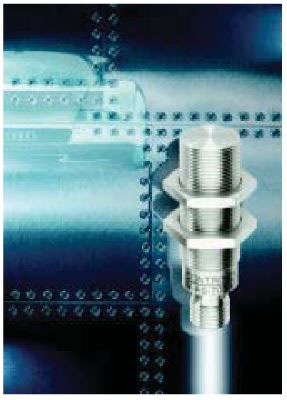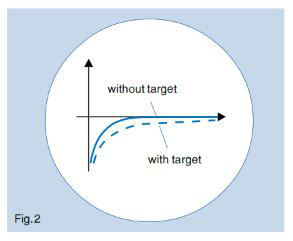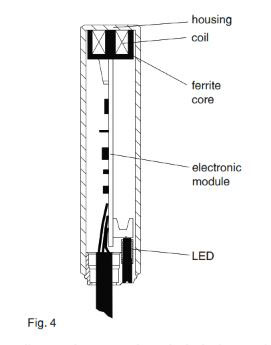Condet Proximity Switches
Contrinex 12th Dec 2022
Why inductive?
Inductive proximity switches are highly popular with end-users. They are:
- robust
- good value for money
- insensitive to dirt
- standardized
- good value for money
- insensitive to dirt
- standardized

and, as a result, simple to employ. Although this type of device has been manufactured for decades, development has not stood still. Contrinex now offers inductive proximity switches which function using the completely new Condet technology the conducting target, provoking a current flow. When the transmitter current pulse is abruptly switched off, the object becomes the primary coil. The residual current flowing in it at that moment fades away, thereby inducing a voltage in the device coil, which is now the secondary coil (Fig.2). This reverse induced voltage is evaluated by the device. In the underlying induction principle, as is well known, neither temperature nor losses occur, which has a correspondingly and have interesting properties.
Advantages of Condet Technology
- The devices (including sensing face) are built into a one-piece stainless steel housing and are therefore extremely robust.
- They achieve long operating distances on steel.
- Similar long operating distances on aluminum, brass, etc.
In short, these are the essential advantages of the new proximity switches relative to the standard ones currently used in large numbers. They therefore fulfil the most important, long outstanding end-user desires.
Operating Principle
The new technology varies considerably from that used previously. It permits innovative proximity switches that have previously been inconceivable.
The devices of the previous generation contain a front-mounted coil, which forms part of the oscillator circuit of a high-frequency oscillator. The coil produces a high-frequency magnetic field in front of the sensing face; conducting objects brought into this area increase the oscillator circuit losses, which are detected and evaluated by the built-in electronics. Unfortunately, the oscillating circuit is also affected by other, undesirable influences, in particular temperature and time dependent losses. As a result, the oscillator stability, and with it the achievable operating distance, are limited.

A new type of device, working essentially like a differential transformer, exhibits none of the above-mentioned disadvantages. This, however, has only been achieved at great technical expense, since at least two coils, an emitter and a receiver, have to be used. Today's most widely used device of this type even has three coils.
By contrast, the Condet technology works in principle like a conventional transformer. In this case, only a single coil is found behind the sensing face. To start off with, this serves as the primary coil during the transmitter current pulse (Fig.1). This transmitter current pulse sets up a magnetic field in front of the coil. As in the case of a secondary coil, a voltage is induced in positive effect on Condet technology behavior.

The cycle time (comprising of emission, delay, and reception times) is in the order of 100 to 200 µsec. This corresponds to a frequency range some 20 to 100 times lower than with conventional devices. Interestingly, as a result, the penetration depth of the magnetic field in conducting materials increases sharply. Moreover, if a non-magnetic material with a relatively high specific resistance is chosen, e.g. stainless steel, the penetration depth can reach 1 to 2 mm. This property can be put to good use: the sensing face of the proximity switch can be made from such a metal.
Construction

The internal construction of the new proximity switches scarcely differs from those usually found in the market. There is only one, albeit fundamental, difference: the housing is made from one single piece, front face (sensing face) included (Fig.3). For the normal version, the material used is stainless steel. The usual plastic cap on the front face is no longer required. In addition, the stainless-steel cover over the sensing face now present has a substantial wall thickness. In all other respects, the inside of such a device corresponds completely to conventional technology (Fig.4): a coil inserted into a ferrite core, an electronic module, a LED, connecting leads or connectors according to the type, the whole being resin potted.

Properties
The devices are basically what their name implies: proximity switches, as have been known for a long time. Only the three most important differences with respect to devices normally available in the market are therefore described below.
1. Housing in one single piece
Leaving off the previously necessary plastic cap over the sensing face removes the most important weakness of proximity switches used up till now. Unfortunately, conventional devices are mechanically weak precisely at the place where the danger of overstraining is highest: at the front, opposite the target, which is generally moving. Here, the new devices, with a wall thickness of 0.5 to 1 mm (stainless steel), have outstanding mechanical resistance. In addition, a joint, which has until now frequently caused permeability problems, followed by early failure, has been eliminated: between the metal sleeve and the plastic front cap. Naturally, there is no seal with a one-piece housing. Impermeability is therefore guaranteed without restriction. Additionally, devices in standard executions are also already suitable for use under severe pressure conditions (up to approx. 20 bar). The exact values can be obtained from the data sheets.
2. Long operating distances
The operating distances reach very high values. The advantages of long operating distances are sufficiently well known:
- Increased distance from moving parts, thereby reduced danger of mechanical damage, and consequently increased operating reliability.
- Reduced demands with respect to mechanical installation tolerances, thereby reduced costs.
- Simpler adjustment during mounting.
- Safer replacement by maintenance personnel.
Table 1 shows a comparison with previous technology. The values refer to a standard steel (type FE 360) target. The devices for embeddable mounting are moreover fully flush-mountable without restriction (Fig.5).
3. Long operating distances on aluminum, brass, etc.

Conventional proximity switches achieve their greatest operating distance on steel. The stated operating distances given by manufacturers, as well as the corresponding standard, always refer to this material. In the case of other metals, the operating distance is reduced by a correction factor. Typical values are shown in Table 2. This means a considerable reduction of application possibilities. For a few years, as mentioned above, additional devices have therefore been available with a correction factor of virtually one, i.e. the identical operating distance on all common non-ferrous metals.
Similarly, devices made using Condet technology give very good results on non-ferrous metals. However, the correction factor is not always exactly equal to one. Table 3 shows typical values for the most frequently used metals (size M12 non-embeddable).
The correction factor between steel and aluminum is set at the factory to one, since aluminum, next to steel, is the most frequently used metal. As a result of the high penetration depth of the magnetic field in stainless steel and other non-magnetic, poorly conducting metals (see above), the operating distance on thin sections of these materials is reduced. In fact, it is this effect which makes a one-piece housing possible. The given values refer to a standard 1 mm thick target. In this case also, excellent results are obtained with greater material thicknesses (Table 4, values for size M12 non-embeddable).
Applications
The new proximity switches are suitable for nearly all uses where inductive proximity switches have been used up till now. Their long operating distance and robustness in the area of the sensing face are always important pluses into the bargain. The very special advantages of the new device, however, really only come fully into play in a few well-known difficult application fields:
- Metal working machines: completely insensitive to permanent contact with aggressive cutting oils and drilling emulsions; high resistance to sharp-edged, hot slivers.
- Food industry: no hygiene problem at the joints, no plastic, unlimited resistance to cleaning with aggressive, hot cleaning agents, even in high-pressure jets.
- Chemical industry: degree of protection IP 68 already achieved with the standard version (cable connection). Resistant to many reagents. Special versions with housings of acid-resistant steels are possible without problem.
- Automobile industry: very good results for the detection of aluminum parts, a metal which is used more and more in vehicle construction for weight considerations.
Tip: With suitable choices of materials and wall thicknesses, metallic objects can also be detected through metal barriers!
Limitations
As described above, Condet proximity switches work in a similar way to transformers. The target must therefore have a certain surface area. For detecting one-dimensional parts, e.g. thin wires, the process is less suitable. In such cases, devices using Condist technology (also from Contrinex) are superior.
For detecting parts of non-magnetic, poorly conducting metals (stainless steel, zinc, lead, chromium, titanium, etc.), care must be taken to ensure sufficient object thickness (see Table 4 above).
Condet proximity switches can (as is also the case for conventional devices) be disturbed by magnetic fields with frequencies in the order of magnitude of the operating frequency of the device. This results in inaccurate switching behavior. It should therefore be borne in mind that the operating frequency of Condet switches, as mentioned above, is substantially lower than that of conventional devices.
Economic Aspects
On the grounds of its simple concept, Condet technology makes economic manufacture of the devices possible:
- The one-piece stainless steel housing is not more expensive than a conventional brass one when the additional costs for galvanization, the plastic cap, and their assembly are taken into consideration.
- The device needs only a single, simple coil; no high-frequency braiding, no tapping.
- The electronic module consists of a simple ASIC and a few unobtrusive SMDs, just like standard devices found in the market.
Summary
Proximity switches made according to Condet technology exhibit all the properties that have helped the inductive proximity switches available in the market to achieve their popularity and wide usage. On top of these, there are a few important characteristics which broaden the application area, simplify use, and increase operation reliability: a robust, one-piece, impervious, stainless-steel housing, and long operating distances that in addition are also achieved on aluminum, brass, etc. Furthermore, the economic efficiency of previous devices is completely preserved.
12th Dec 2022


